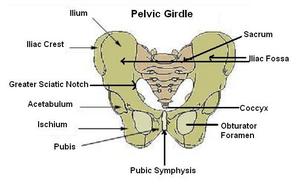Forensic anthropology is an important part of the forensic sciences. The forensic anthropologist’s ability to identify human remains is an invaluable skill. This article explains the important information a forensic anthropologist can gather from a human pelvis.
When remains are significantly decomposed or skeletanized, a forensic anthropologist will often be called upon to help determine the age, sex, race, and height of the decedent. Any visible injuries which may have led to death of the decedent– for instance, bullet holes, knife wounds, or blunt trauma, will also be carefully noted. Remaining tissue, if present, is examined for insect activity and other potential clues.
After gathering and documenting evidence from the tissue, the forensic anthropologist then cleans the bones –often by boiling them to remove the flesh (sometimes cadaver beetles are used, but this takes longer than boiling. And, yes, I will attest– from personal experience– that the smell that arises during the process is very bad–even if the cadaver is a fresh donation from the medical college. This discipline is not for the squeamish). Next, the forensic anthropologist examines and measures the bones.
Diagrams of pelvic areas accompany this article; however, for additional clarification, I am including brief descriptions of the areas and definitions of terms used:
Pelvis: The pelvis actually consists of three bones: the two innominates and the sacrum.
Innominates: The hip bones. A hip bone consists of three bones that fuse at puberty: the ilium, ischium, and pubis.
Ilium: The largest bone of the hip bone. The Ilium is also called the iliac bone.
Iliac Crest: The Iliac crest is a bony crest at the top of each hip bone.
Iliac Fossa: The Iliac Fossa is the slightly concave area on the inner part of each hip bone
Ischium: Simply, this is the bone you feel when you are sitting.
Pubis: the pubic bone.
Pubic Symphysis: A joint connecting the right and left pubis.
The Greater Sciatic Notch: A notch located on both hip bones, facing towards the posterior.
The Sacroiliac Joint: The joint connecting the sacrum to the hip bones.
The Sacrum: The bony, somewhat triangular, structure directly below the lumbar vertebra.
The Coccyx: The coccyx is connected to the sacrum and is commonly called the tail bone.
Auricular Surface: The area where the Innominate and sacrum connect.
Obturator Foramen: The two holes, which look like large eye sockets, in the area of the ischium and pubis.
Determining age of a decedent via pelvic morphology:
In cases where the hip bones have not fused, it is safe to assume that the remains are those of a child.
Examining the pubic symphysis: In adulthood, the pubic symphyseal surface (the area where the right and left sides meet) begins to change. For example, in the early adult years, the surface tends to have the appearance of a small, rugged mountain chain. The surface gradually erodes, in somewhat predictable ways, and develops a new landscape.
Data has been collected for many years on what kinds of changes occur–porosity, billowing, grooving, and pitting etc.– and at what age range. To view two charts used to determine age via changes in symphyseal surface, please see the link in the resources section of this article or click here to see the diagrams now.
As adults age, the auricular surface changes significantly and distinctly. As with the pubic symphysis, many studies have been done and a lot of data collected about what changes occur and when they occur. For information on each age range and the accompanying morphology, you can click here .
Additional morphological changes occur in the pelvis during aging, but for the purpose of this article, the preceeding should give you an idea of how age can be approximated or determined via the pelvic bones.
Determining sex of the decedent via pelvic morphology:
After eyeing the overall appearance of the pelvis, the forensic anthropologist will examine the Greater Sciatic Notch. The Greater Sciatic Notch is wider, broader in female specimens. Before actual measurements are taken with a caliper, the thumb test is usually used. The thumb test is simply as follows: by placing your thumb in the notch you determine the roominess. If there is a lot of room to move the thumb about, you are likely dealing with a female. If the notch is narrow, the specimen is likely male.
Forensic anthropologists also look at the obturator foramen, which in females is more triangular than the obturator foramen in male specimens.
Subpubic angle: the female pubic angle is distinctly wider. Measurements are taken and are compared with the measurements of other pelvic landmarks to help with accuracy in determining sex.
On many occasions, something called birth scarring might be present on the pelvic bones. This pitting or grooving of pelvic areas can occur with pregnancy. If the decedent was elderly, however, there is a chance that birth scarring may have been obliterated during the natural aging process. When I studied forensic anthropology in the mid 1990’s, birth scarring was considered a fairly accurate indicator that the decedent had had pregnancies at some point during life. However, some kinds of pitting and grooving once associated with pregnancies have since been found in individuals who had never been pregnant.
I have based this article on knowledge gathered during my forensic studies in the mid 1990’s. I have revisited data to help insure that the information supplied here is, to the best of my knowledge, up to date. Forensic anthropology is, however, a dynamic, growing field. New, more accurate, methods are likely being tested right this moment. Nevertheless, this article covers important basic information and methods currently used. I hope this gives you a good idea of the amazing amount of identifying information gathered just from the human pelvis alone.
If you are interested in reading about the human skull, click here for my article on forensic anthropology and the skull.






